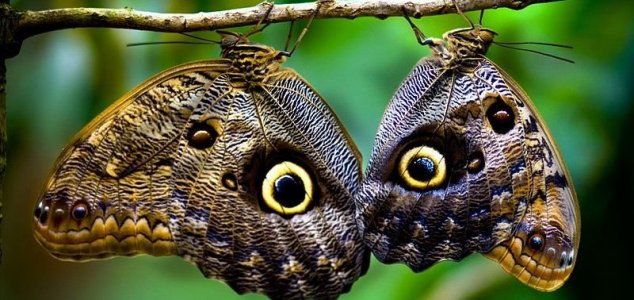Palaeontology
February 12, 2016 · 4 comments
4 comments

Lacewings had eye-like wing patterns similar to modern butterflies. Image Credit: CC BY-SA 2.0 Edwin Dalorzo
The discovery was made thanks to two well-preserved fossils recently unearthed at a dig site in China which, for the first time, have made it possible for scientists to fully appreciate the extent to which these prehistoric winged insects resembled modern butterflies.
"Poor preservation of lacewing fossils had always stymied attempts to conduct a detailed morphological and ecological examination of the kalligrammatid," said scientist David Dilcher.
"Upon examining these new fossils, however, we've unraveled a surprisingly wide array of physical and ecological similarities between the fossil species and modern butterflies, which shared a common ancestor 320 million years ago."
Scientists now believe that lacewings, just like their modern counterparts, would have sustained themselves by visiting plants and lapping up the nectar using their long tongues.
There is even evidence to suggest that, like today's insects, lacewings would have helped to maintain the reproductive cycle by transporting pollen from one plant to another.
"Here, we've got coevolution of plants with these animals due to their feeding behavior, and we've got coevolution of the lacewings and their predators," said Dilcher.
"It's building a web of life that is more and more complex."
Source: Discovery News | Comments (4)
Prehistoric 'butterfly' fossils discovered
By T.K. RandallFebruary 12, 2016 ·
 4 comments
4 comments
Lacewings had eye-like wing patterns similar to modern butterflies. Image Credit: CC BY-SA 2.0 Edwin Dalorzo
A type of insect that looked very much like a modern butterfly was common during the Jurassic period.
Known as Kalligrammatid lacewings, these prehistoric flying insects were remarkably similar to their modern counterparts and even possessed familiar wing markings still seen in butterflies today.The discovery was made thanks to two well-preserved fossils recently unearthed at a dig site in China which, for the first time, have made it possible for scientists to fully appreciate the extent to which these prehistoric winged insects resembled modern butterflies.
"Poor preservation of lacewing fossils had always stymied attempts to conduct a detailed morphological and ecological examination of the kalligrammatid," said scientist David Dilcher.
"Upon examining these new fossils, however, we've unraveled a surprisingly wide array of physical and ecological similarities between the fossil species and modern butterflies, which shared a common ancestor 320 million years ago."
There is even evidence to suggest that, like today's insects, lacewings would have helped to maintain the reproductive cycle by transporting pollen from one plant to another.
"Here, we've got coevolution of plants with these animals due to their feeding behavior, and we've got coevolution of the lacewings and their predators," said Dilcher.
"It's building a web of life that is more and more complex."
Source: Discovery News | Comments (4)

The Unexplained Mysteries
Book of Weird News
AVAILABLE NOW
Take a walk on the weird side with this compilation of some of the weirdest stories ever to grace the pages of a newspaper.
Click here to learn more

Support us on Patreon
BONUS CONTENTFor less than the cost of a cup of coffee, you can gain access to a wide range of exclusive perks including our popular 'Lost Ghost Stories' series.
Click here to learn more
Coronavirus (COVID-19) Pandemic
United States and the Americas
Palaeontology, Archaeology and History
Earth, Natural Disasters and the Environment
Total Posts: 7,779,602 Topics: 325,648 Members: 203,949
Not a member yet ? Click here to join - registration is free and only takes a moment!
Not a member yet ? Click here to join - registration is free and only takes a moment!



































Please Login or Register to post a comment.